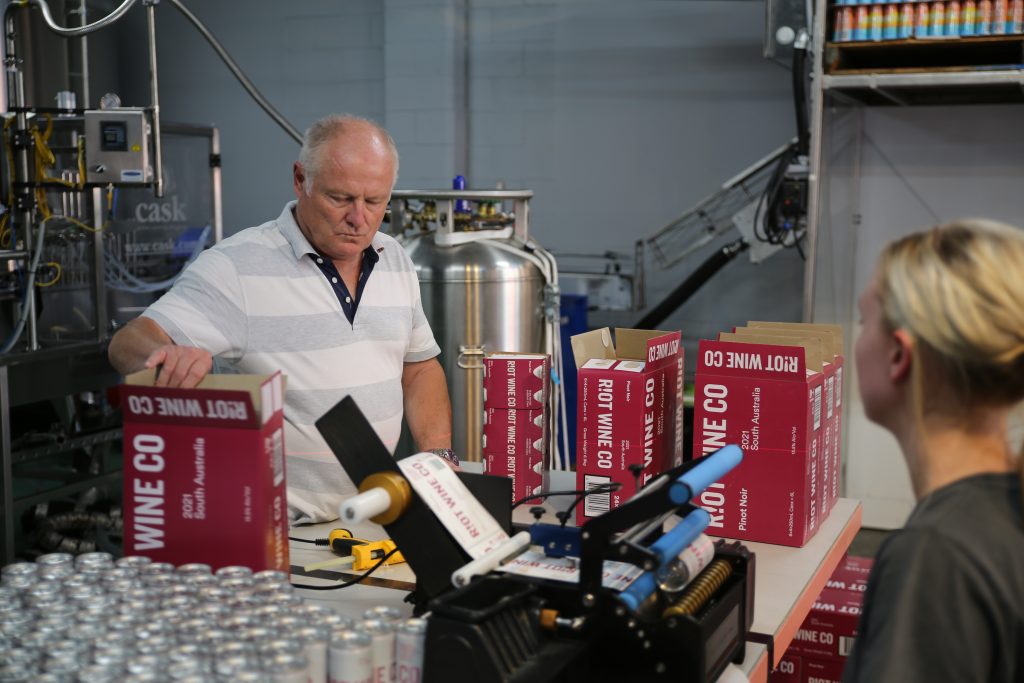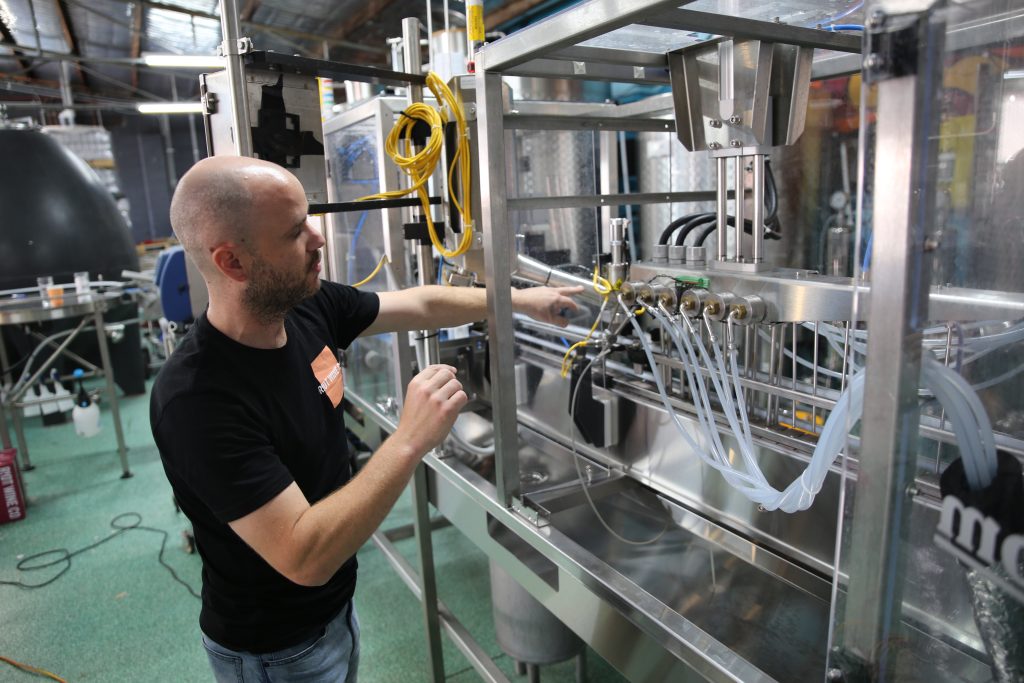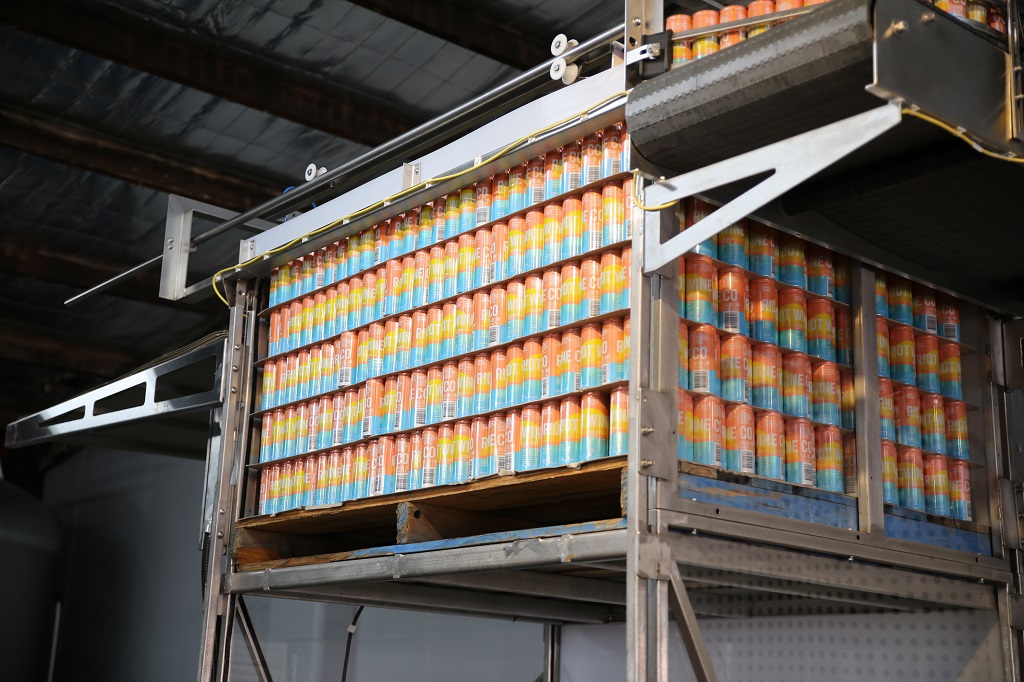Cans waiting to be filled on the de-pallatiser, which lowers them to the machine to be injected with hydrogen and sealed. Photo Harrison Davies
A changing environment for wine packaging
Although still a small segment of the market for wine products, cans saw the greatest increase as a proportion of wine packaging market in the 2010s. Changing technologies and attitudes toward alternative wine packaging have allowed a niche to become more accepted. Harrison Davies spoke to innovators in Australia’s canned wine scene to explore how the canning and winemaking process for canned wine differs from that of bottles.
The global market value for canned wine grew by over 50 per cent, or by over US$75 million, from 2016 to 2020 according to a 2020 market study by American research firm Grand View Research (GVR).
This is recognised as the fastest growth amongst any wine packaging across the market and statistics suggest the trend will continue to grow at a compound annual rate of roughly 13% a year.
The growth of canned wine follows similar trends amongst other commodities of food and drink representing a market desire of quick, easy, individually packaged goods.
Sparkling wine is the largest part of the canned wine industry and accounts for more than half of all canned wine sales globally.
Canned wine has seen massive popularity in Japan since 2005 and a fast growing market share in both America and Australia in the last five years.
On top of changing tastes, technology has improved in recent years and made it easier to package wines in cans, which was previously seen as a challenging liquid to store in cans due to high acidity and the presence of alcohol.
South African wine researcher Carien Coetzee highlighted in a report to Winetech the challenges posed by canning wines and how the process differs from bottling.
“Using aluminium cans as a packaging material for wine can pose challenges as it can be harder to maintain consistency and quality… all wines made for canning can also be packaged in glass bottles, but not all wines prepared for glass bottles can be canned,” she explained.
“The winemaking process for the different packaging options is fundamentally the same. However, there are a few key parameters or risk factors which need to be carefully considered in order to maximise the product’s shelf life, ensure customer satisfaction, and prevent product loss.”
Perceptions toward canned wine in Australia are also changing, with several wineries championing the packaging at the forefront of their business.
Amongst these brands is Riot Wines, a McLaren Vale based winery that began its life with keg wine and expanded to cans in 2018.
Riot co-founder and chief winemaker Tom O’Donnell said the only reason canned wine had a stigma was because companies were using bad wine for their canned offerings.
He said that due to the cost of packaging the wines being so low, bigger corporations would use lesser products to hike up their profit margins, creating a reputation of canned wine being bad.
“They tend to put cheap, horrible wine in the format. It was capitalised on margins and, unfortunately, they’ve almost burnt the category because there was some really s**t can wine around,” O’Donnell said.
Can-do attitudes

There are several benefits to using cans as a medium to sell wine. They are much cheaper to produce and to ship than bottles due to being much lighter and they are also more environmentally sustainable as a vast majority of aluminium, approximately 74 per cent, is recycled.
However, wine canning can pose some challenges to winemakers looking to get a foot in the market.
In many cases, the canning facilities must be owned by the brand itself, as most major industrial canning facilities require high volume to be used.
This makes the overhead for many wineries quite high, and as stated before, the wine has to be made specifically to be canned, not just what gets sold in a bottle.
“It seems really silly but you can’t just fill a can and put a lid on it and hope for the best,” O’Donnell said.
“You have to make wine for the purpose [of canning]. If you don’t, then you shouldn’t do one.
“The canning process now that we’ve got is like, it’s brilliant. It’s easy. But I mean, getting a canning line is no small feat.
“We now have our own canning facility so we are very fortunate but if you don’t, your minimum can run to print cans is 60,000.
“It costs a lot of money to get a canning line up and running. That’s certainly another barrier to be challenged to market.”
These two factors make entering the market challenging for smaller businesses, especially when canned wine sales still lag far behind other products.
Wine cans are also not simply interchangeable from those one would find in the beer or soft drink aisles, as wine is acidic and aluminium is highly reactive.
Wine cans must lined with a thin, corrosion-resistant, non-porous lacquer.
This is done both to prevent the wine from being contaminated and to maintain the structural integrity of the can itself.
“Different lacquers can be used for the internal coating of the can and the lacquer used for the can end coating may differ from the lacquer used for the body and base,” Coetzee said.
“Can suppliers differ in their lacquer offering, each with unique properties. South Africa’s largest aluminium can producer, Nampak Bevcan, uses a customised Food and Drug Administration (FDA) approved epoxy phenolic lacquer for ‘hard-to-hold’ beverages such as wine.”
However, even with these linings, best practise must still be maintained when producing the cans so as to ensure uniform coverage of the lining.
“Too little spray may result in a porous layer, incomplete film coverage and/or pinholes. These create vulnerable spots potentially causing direct contact between the wine and the aluminium,” Coetzee continued.
“However, too much spray can produce bubbles, puddles, and blisters that can trap the coating, leading to poor curing/setting of the lacquer.
“The speed of the production line can affect the evenness and the thickness of the coating applied.
“Wine is considered a chemically aggressive medium due to the presence of alcohol, sulphur dioxide, high acidity and low pH.
“This combination creates a hostile environment for innovative packaging materials such as aluminium.”

producers to fill and seal
more than 2000 cans an
hour with all hands on deck. Photo Harrison Davies
Trusting the process
Canned wine takes a different shape from bottled wine for several reasons, predominantly because of the lack of exposure to air.
Cans are an air tight medium, meaning the enzymes within the wine will not react with their environment in the same way they would in a bottle.
Winemakers must bring this into consideration when making wine to be canned, and O’Donnell said the perception of how wine is kept and enjoyed in a can is completely different from a bottle.
“You literally just have to start with the end in mind. You’re making a wine that’s intended for the format of how it’s going to be drunk,” he said.
“When you package wine in a can, there’s no light and oxygen [which is] completely different to a glass bottle. So you’re really always tracking that wine in a steady state.
“Considering that we have to do all of the winemaking in the winery and then package [the wine] we don’t have the benefit where you put it in bottle and then watch it age and evolve over time.”
Because a lot of the ageing is done in the winery itself, O’Connell said they mostly focussed on whites, light reds and rose wines.
You literally just have to start with the end in
mind. You’re making a wine that’s intended for the
format of how it’s going to be drunk. – Tom O’Donnell
Because of the air-tight seal, O’Connell also suggested that canned wines would be better for consumers who want to try a variety of styles or not drink too much in one go.
“Using cans allows consumers to have one drink at a time, as opposed to a bottle where they must finish the whole thing once it’s opened or it will be ruined,” he said.
“The wine is at a stage where it is ready to be drunk as soon as it is bought and because it is sold in serving sizes in cans, allows consumers to have one drink and not worry about what to do with the rest.”





















